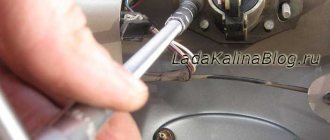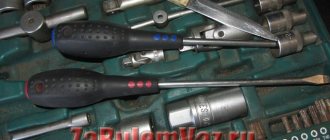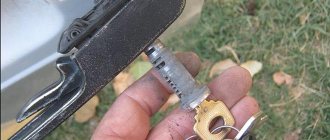Physics is not in your favor
The above problems occur due to the fact that in the cold, water turns into ice and “fetters” the lock mechanisms. It gets there either during washing, after which it is important to thoroughly blow out the openings and locks, or it accumulates on its own during operation - and at the most inopportune moment it turns out to be enough to cause problems for the motorist. The same applies to freezing door seals: you can either not get into the car or use excessive force and break the rubber bands. What to do to avoid these troubles?
They have already said about washing: it is necessary to blow through both the openings and the locks - their cylinders and the actual locking mechanisms located at the ends of the doors. Door seals and interior parts should be wiped dry and should not be left wet. If the situation is frosty, we recommend slamming the doors thoroughly half an hour to an hour after washing - this way you will “shake off” the ice that has just appeared and is not yet very strong.
The best remedy is prevention
The risk of problems can be significantly reduced by pre-treating the parts with suitable products. And here the choice will depend on the node. So, it is better to pour a little universal lubricant into the lock cylinders - mineral oil without additives. If there is no such thing on the farm, regular motor oil will do.
But it is better to treat door hinges and locking mechanisms with a special adhesive lubricant. The fact is that these parts have friction between each other; ordinary oil does not stay on them for a long time. Therefore, it is preferable to use special products that “stick” to materials and cannot simply be removed. In this case, it is better to use lubricants with Teflon additives, which will also prevent the adhesion of dust (these are used, for example, for motorcycle chains). An important point: these products are not suitable for treating larvae, because they can simply cause the secret parts of the mechanism to stick.
You may say: why such difficulties? Isn’t it easier to use a universal product like WD40? No! Even though the “Vedeshka” has cleansing properties and displaces moisture, it cannot be considered as a protective agent, it is too “dry” and additional lubrication is needed.
Protective lubricants, advantages and disadvantages
Today, a huge range of means is known that meets the goals of protecting the castle. For example, you can use silicone, graphite and lithium compounds, produced in the form of lubricants and even aerosols. To this “triad” you need to add the well-known product offered under the brand “WD-40”. Well, Russian developers have their own composition, also suitable for these purposes. Let's compare everything and start with the most ambiguous.
Composition of WD-40 and its analogues
In the 20th century, a product called WD-40 was invented in the United States. It is recommended to be used for removing rust, as well as for protective metal treatment. This product leaves marks on the varnish, which, however, can be easily removed with clean water and a cloth.
WD-40 spray
The minimum volume of packaging with the liquid in question is 80 ml. However, to protect the lock, it is better to buy an aerosol (here the volume starts from 100 ml). The cost of aerosol and liquid lubricant differs significantly, but for your favorite car you can spend it once.
Once you decide to use WD-40 to protect locks, you need to prepare for the following:
- WD-40 liquid leaves traces on the paintwork. If left for a while, the product may be absorbed. And you need to wash it off with water, water with powder, or in difficult cases with white spirit.
- If you treat the lock with WD-40 once, then perhaps nothing bad will happen. After repeating the treatment 2 or 3 times, you will notice the following: the larvae freeze after washing. To counteract this, the treatment is repeated after each wash (we are talking about the winter period).
From point “2” we can conclude that WD-40 is effective, but at the same time it has its own specifics. It will have to be used after every winter wash. If you are ready to accept it, use it.
Silicone, graphite and lithium help
The protective agent may contain one of the following components: silicone, graphite powder, lithium. The last option, that is, lithium grease, should not be confused with lithol - a much more inexpensive and less effective product.
Lithium Lock Spray
Each of the mixtures offered by the manufacturer contains one of the listed fillers: either graphite, or lithium, and so on. Compositions of each of the three types can be offered in the form of a liquid lubricant, but also in the form of an aerosol.
The chemicals mentioned in the text above have their advantages and disadvantages:
- A lubricant containing lithium is the most effective option of the three. A significant drawback, however, will be the price. In addition, according to reviews, lithium compounds do not tolerate the “transition through 0” if it occurs repeatedly. But if there are no frequent thaws in winter, this drawback is insignificant.
- Silicone-based spray is a universal composition suitable for metal processing and more. They can also protect rubber surfaces (door seals) from frost. But you need to make sure that the product does not get on the plastic.
- Lubricant with graphite powder, in theory, is designed to protect low-speed, highly loaded mechanisms. The point is that even if the viscous base dries out, graphite remains, which reduces the coefficient of friction.
Graphite compounds are actually used to protect locks. But there has been little feedback on this issue so far. In any case, when buying this or that material, you need to look at the freezing temperature, which is indicated on the packaging or in the instructions. It can reach - 40 – 60°C.
No preparatory work is carried out before applying the mixture. There is no need to degrease the metal, and it is impossible. The aerosol tip is brought to the cylinder and pressed on the cap:
Processing the door lock cylinder
Of course, the kit must include a special spray tube. Otherwise, nothing good will come of it.
It is important to know that all of the tips listed apply only to processing locks.
Other parts and components, including the internal lock mechanism, are treated with machine or transmission oil. All this is detailed in the car manual. Lithium greases are generally not applicable anywhere except the lock cylinder. This must be remembered.
Silicone is power! Sometimes excessive...
To prevent freezing of rubber and plastic parts (doors, windows, door handles), it is recommended to lubricate them with silicone lubricants. Which is what many motorists do, sometimes with great zeal. Meanwhile, it should be borne in mind that silicone has strong anti-adhesive properties, so getting it on the paintwork of the body is very undesirable. In the case of painting repairs, this may result in the appearance of craters where silicone molecules remain (not every solvent accepts it).
Second point: if silicone gets on the glass, an oily film will form. And if the windshield wiper blades start to smear it... In general, despite the fact that silicone lubricants are sold in spray cans, it is better not to spray them, but to apply them to a sponge and use it to treat the plastic and rubber parts that require it.
Not just doors
One more note. During preventive measures, remember not only about the side doors - do not forget about the hood, trunk and gas tank flaps. And also about the neck plug, if it has a key. It’s not very pleasant to find yourself in a situation where you’re already close to the pump, but you can’t reach the plug. However, this is not the worst scenario, since at a gas station you can always find the opportunity to defrost the lock. But if you have an old Ford, where the hood can be opened with a key, there is a possibility of finding yourself in a stupid situation. Moreover, the lock behind the front emblem often freezes or even turns sour.
How to deal with frozen car door locks
Sometimes your car doors may be fine, but still you will not be able to get into the interior. The reason is frozen door locks. The fact is that door locks can also accumulate moisture, which freezes due to negative temperatures. As a result, frozen locks will not allow you to unlock the doors.
To prevent your car locks from freezing, you will need a moisture-displacing chemical. For example, WD-40 spray (“Vedeshka”) is excellent at displacing moisture. To protect your car locks from freezing and icing, apply WD-40 directly to the lock.
This will remove excess moisture from the car lock, as well as protect it from further water and moisture entering the locking device.
Also, many car dealerships sell a special lubricant that protects locks from freezing, which also needs to be used to lubricate all elements of the lock.
Unfortunately, many of us begin to think about protecting doors and door locks from freezing only when this has already happened. So, if you were not prudent before the start of the winter period and were faced with the fact that the door locks in your car froze, then fortunately not all is lost, and you will still open the car. Here's what you should do:
- — Buy a lock defroster. Treat your car key with it. You can also treat it with regular medical alcohol before inserting the key into the door lock. Then slowly insert the key into the lock and turn it.
- - If you do not have a lock defroster, use a hair dryer to warm the lock. Then slowly insert the key into the door lock and turn it.
- — If you don’t have a lock defroster, a hair dryer (or nowhere to plug it in) and alcohol to warm up the key and lock, then you can use your own body heat to warm up the car key. To do this, take the key in your hand. With your other hand, you should heat the lock cylinder in the door by placing your finger against it. This will allow the ice on the surface of the lock cylinder to melt a little. Then, after heating the key a little, slowly insert it into the lock. Then take out the key and heat it again by hand.
Be patient when you try to open a frozen car door by turning the key. If you turn the key too quickly or harshly, you may not only damage the lock, but you will easily break the key.
How to defrost?
Let's say you decide to do without prevention or it was not enough to protect the locks from freezing. What should I do? At one time, we tried a variety of methods for defrosting lock cylinders, starting with the use of special means and ending with old-fashioned methods. Their effectiveness and further consequences (what happened to the lock after some time) are clearly demonstrated by this table:
| Defrosting method | Time spent | In 30 minutes | In 60 minutes |
| Breathing | 6 minutes 37 seconds | the key cannot be inserted | |
| Exhaust gases | 5 minutes 12 seconds | the key cannot be inserted | |
| Heat the key with fire | 4 minutes 7 seconds | the key won't turn | |
| Hot water | 2 minutes 7 seconds | the key won't turn | |
| Vodka | the key cannot be inserted | ||
| Hawthorn tincture | 6 minutes 15 seconds | the key is inserted and turned | |
| Brake fluid | 4 minutes 57 seconds | the key is inserted and turned | |
| Ice defroster 1 | 5 minutes 10 seconds | The key is difficult to insert and turn | |
| Ice defroster 2 | 7 minutes 15 seconds | Everything is fine | with difficulties |
| WD40 | 15 minutes 35 seconds | with difficulties | the key won't turn |
As we can see, only after using defrosters (and also hawthorn tincture containing more than 60% alcohol) did the locks retain their functionality some time after defrosting. Traditional methods allow you to open the door (hatch), but then, in order to avoid repeated “sticking” of the mechanism, it must be treated with a moisture-displacing agent and lubricated.
What to do if it is the locking mechanism that freezes? Sometimes this happens when the door is open and the lock does not engage. This is not the worst option, because you have access to the mechanism itself, it can be treated with one or another means. Or warm up the interior thoroughly - and after some time the lock will work. True, once the author of these lines had to warm up while driving, and in order for the door to remain in the closed position, he had to fasten it to the center pillar with a seat belt...
It’s worse if the lock is frozen in the closed position and the door (trunk lid) cannot be opened, and there is no alternative access. Here you will have to warm the castle from the outside. The options may be different: use a heating pad or simply a plastic bottle filled with hot water, supply exhaust gases through a pipe, or in critical circumstances, pour hot water on the door, which is harmful to the paintwork. In any case, the effectiveness of these methods is not very high. To increase your chances, you need to heat exactly the area of the body where the locking mechanism is located.
Additional means to lubricate the lock
The lubricants described above relate to modern developments and results of the chemical industry. However, before their appearance, drivers for decades used various improvised means to lubricate locks and door hinges. For example, kerosene, acetic acid and even iodine. Let’s present for you a couple more, so to speak, “folk” remedies that you can use to lubricate car door locks for the winter. After all, it is during the cold season that locks create additional difficulties in order to get inside or close the door. And the question of which lubricant is better to lubricate becomes more relevant.
WD-40
Processing of VAZ 2108-2109 locks
Yes, the good old WD-40 lubricant can also be used to inject into the lock cylinder, but in no case on all its rubbing mechanisms. The fact is that the main component of this product is white spirit (50% of the volume), whose freezing point is -60°C. Therefore, it washes away any remaining lubricant. The liquid is sold as an aerosol in a can with a tube, with which you can easily spray the product into hard-to-reach places.
WD-40 lubricant can be used to dehydrate the surface to which it is applied, removing corrosion from it and preventing its reappearance, forming a protective film on it. In general, the product is used very widely. And not only for processing car parts, but also in everyday life.
A significant disadvantage of treating locks with WD-40 is its short duration of action. In severe frosts, the larva must be treated with this product approximately every two days.
When treating a door lock with a “wedeshka” (both automobile and household), it is advisable to apply silicone grease to the same surfaces. You can use one of the lubricants listed above, or use any other.
Lock defroster
Various defrosters
In this case, we are talking about special products, the packaging of which says “Lock defroster” or something similar. They usually contain oil or white spirit, less often silicone. Such products are inexpensive and work well, at least in relatively mild frosts. The disadvantage of these products is their short duration of action, since their composition is similar to WD-40.
When purchasing such lubricants, carefully read the instructions. Manufacturers often attribute truly miraculous properties to their products. However, you need to understand that if the product is inexpensive (and most often it is), then you shouldn’t expect any miracles from it. Just regularly treat the lock cylinder and mechanism with “Lock Defrosters” in the winter and you won’t have any difficulties opening it. But only in the spring, after using it, it is recommended to treat the lock mechanism with a different composition. In particular, one that could protect against corrosion and friction.
Engine oil
If for some reason you don’t have any lubricant on hand (one of the above or others), then you can use regular motor oil to lubricate the car door lock both from freezing and for stable operation. Its viscosity, brand and consistency are not important in this case (well, unless it should be frankly black with soot and debris). Using a syringe or other similar devices, you should pour a few drops of oil into the cylinder and/or treat the lock mechanism. This will create a water-repellent film on the surface of its internal parts and prevent freezing.
However, the oil has the disadvantage mentioned above - its effect is short-lived and will also attract dust. Therefore, it can only be used if you do not have more professional means at your disposal. And at the first opportunity, buy any of the lubricants listed above.
Our verdict
Of course, there are no hopeless situations: if you can’t open the car yourself or it’s not possible to use one of the methods indicated above, you can always call specialists or, if nothing and no one helps, even load the car onto a tow truck and take it to a warm box. But we repeat: the best solution to the problem is prevention. Simply treat the locks with a suitable product and you will significantly reduce the risk of problems. And don't forget to take extra drying measures after washing. Smooth roads!
Close everything! Central locks in the Automotive Business ad database











